16 Best Content Marketing Tools in 2023

Content marketing tools have become an indispensable strategy for businesses looking to grow their online presence and establish themselves as industry experts.
Creating valuable and engaging content can help attract and retain customers, increase brand awareness, and ultimately drive sales.
However, creating high-quality content consistently can be a daunting task, especially for small businesses with limited resources.
Fortunately, there are a plethora of free content marketing tools available that can help streamline the process and improve the effectiveness of your content marketing efforts.
In this comprehensive guide, we’ll explore some of the best content marketing tools that can help take your existing content marketing, and strategy to the next level.
Top 3 Keyword Research Tools in 2023

One of the foundational elements of content marketing is keyword research.
It involves identifying the words and phrases your target audience is using to search for products or services related to your industry.
Keyword research tools can help you discover high-volume keywords with low competition, allowing you to create content that ranks well in search engine results pages (SERPs).
| Keyword Research Tools | Reviews | Price | Users |
| Google Keyword Planner | ⭐⭐⭐⭐⭐ | Free | 200000+ |
| Ahrefs Keyword Explorer | ⭐⭐⭐⭐ | 99$/month | 50000+ |
| SEMrush | ⭐⭐⭐⭐ | 119.95$/month | 60000+ |
1. Google Keyword Planner
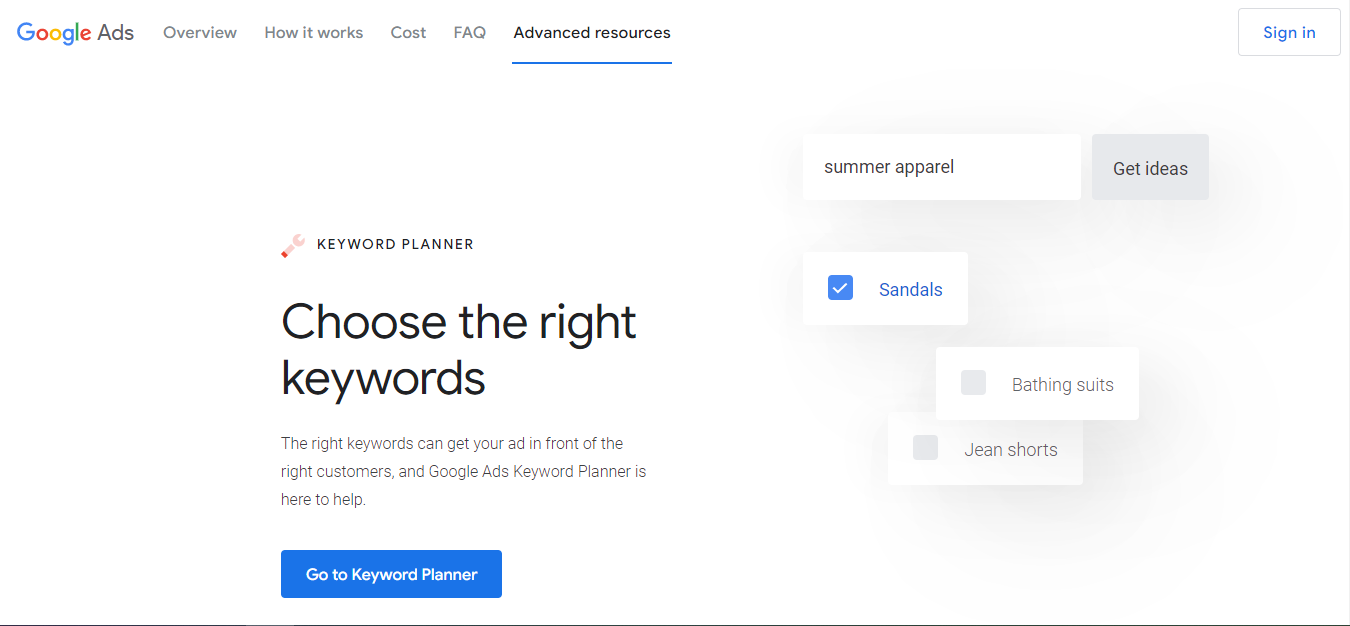
Google Keyword Planner is a tool provided by Google Ads that allows you to research and find the best keywords to target for your content.
It is designed to help advertisers find keywords to use in their Google Ads campaigns, but it can also be used for content marketing purposes.
To use the Google Keyword Planner, you need to have a Google Ads account.
Once you’re logged in, navigate to the Keyword Planner tool in the “Tools & Settings” menu.
From there, you can enter a list of keywords related to your topic or website, and the tool will generate a list of related keywords along with data on their search volume, competition, and suggested bid.
The search volume data shows you how many times people have searched for a particular keyword on Google in the past month.
This can give you an idea of how popular a particular keyword is and whether it’s worth targeting in your content.
Ad campaigns
The competition data shows you how many advertisersare bidding on that keyword in Google Ads.
This can give you an idea of how difficult it might be to rank for that keyword in organic search results.
In addition to keyword research, the Google Keyword Planner can also help you plan your ad campaigns by providing suggestions for ad groups, bids, and budgets based on your chosen keywords.
Overall, the Google Keyword Planner is a valuable tool for content marketers looking to improve their SEO and target the right keywords for their content.
By using this tool, you can find relevant keywords with high search volume and low competition.
This can help you rank higher in search engine results pages and attract more organic traffic to your website.
Google Keyword Planner is Free. All you need is a Google Ads account to use it.
2. Ahrefs Keyword Explorer
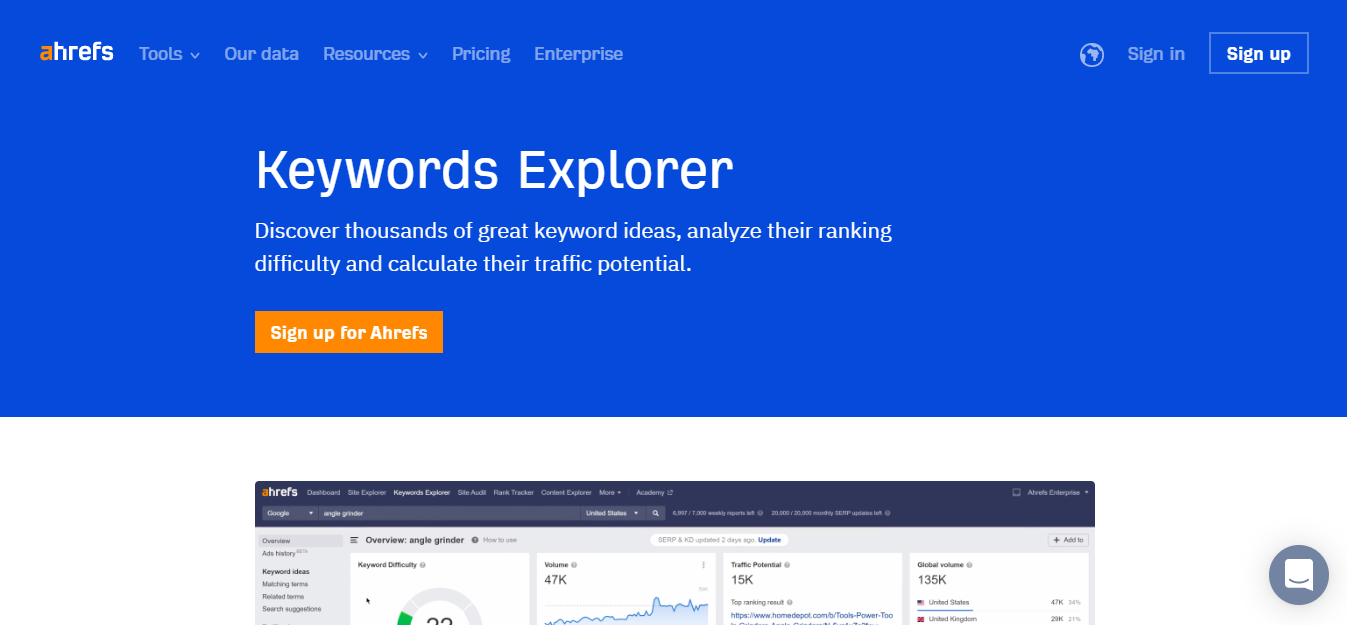
Ahrefs Keyword Explorer is a powerful tool that allows you to find relevant keywords, analyze their search volume and competition, and determine their potential for driving traffic to your website.
You can start by entering a keyword or phrase related to your topic or industry.
The tool will then generate a list of related keywords along with data on their search volume, keyword difficulty, and other metrics.
The search volume data in keyword research tools indicates the number of times a particular keyword or phrase has been searched on Google within a specific time period, usually the past month.
This information can provide valuable insight into how popular a keyword is among users and whether it’s worth targeting in your content.
In addition to keyword research, it also offers features such as:
Keyword Difficulty Checker
This feature allows you to determine how difficult it will be to rank for a particular keyword.
It takes into account the authority of the websites currently ranking for that keyword and the strength of their backlink profiles.
Clicks and Traffic Potential
Ahrefs uses clickstream data to estimate the number of clicks and potential traffic that a particular keyword can drive to your website.
Related Keywords
Ahrefs Keyword Explorer also provides a list of related keywords that you can target in your content.
This can help you expand your keyword list and find new opportunities to drive traffic to your website.
Overall, Ahrefs Keyword Explorer is a valuable tool for content marketers looking to improve their SEO and find relevant keywords to target in their content.
By using this tool, you can find keywords with high search volume and low competition.
This can help you rank higher in search engine results pages and attract more organic traffic to your website.
Pricing starts from 99$/month.
3. SEMrush

SEMrush is an all-in-one digital marketing platform that provides a wide range of tools for SEO, content marketing, PPC advertising, social media, and competitor analysis.
The platform is designed to help businesses and marketers improve their online visibility, drive more traffic to their websites, and generate leads and sales.
One of the main features of SEMrush is its keyword research tool, which allows users to find relevant keywords and analyze their search volume, competition, and other metrics.
The platform also provides a comprehensive backlink analysis tool.
This helps users identify high-quality backlink opportunities and monitor their backlink profile.
In addition to keyword and backlink analysis, it offers a range of other features, including:
Site audit
This tool allows users to analyze their website’s health and identify technical SEO issues that may be affecting their rankings and visibility.
On-page SEO checker
This tool provides actionable recommendations for optimizing individual web pages for specific keywords, including suggestions for optimizing the meta descriptions, tags, content, and images.
Content marketing
It includes a content marketing tool that allows users to research topics, find related keywords, and analyze the performance of their various content marketing tools, campaigns and efforts.
Social media
The platform also includes a social media tool that allows users to manage and monitor their social media accounts, track mentions and engagement, and analyze their social media performance.
Overall, it is a powerful digital marketing platform that provides a wide range of tools and features for SEO, content marketing, PPC advertising, social media, and competitor analysis.
By using SEMrush, businesses and marketers can gain valuable insights into their online presence, identify opportunities for improvement, and the best tools to develop effective digital marketing strategies.
Pricing starts from 119.95$/month.
3 Popular Content Creation Tools in 2023

Once you’ve identified your target keywords, it’s time to create content that will resonate with your audience.
Content creation tools can help you create high-quality, engaging content quickly and efficiently.
| Content Creation Tools | Reviews | Price | Users |
| Grammarly | ⭐⭐⭐⭐⭐ | Free,12$/month | 30 million daily |
| Canva | ⭐⭐⭐⭐⭐ | 119.99$/year | 100 million+ |
| Hemingway | ⭐⭐⭐⭐ | Free,19.99$. | 50000+ |
1. Grammarly

Grammarly is a popular writing tool that helps users improve their writing skills and eliminate errors in their written content.
The tool uses advanced artificial intelligence and natural language processing technology to analyze text and provide suggestions for grammar, spelling, punctuation, and style improvements.
One of the main features of Grammarlyis its web-based editor, which allows users to write and edit text directly within the application.
The editor includes a range of tools and features, such as a built-in grammar checker, contextual spelling checker, and a vocabulary enhancer, which provides synonyms and suggestions for more precise and engaging word choices.
In addition to its web-based editor, it also provides a browser extension that can be used with popular web browsers like Chrome, Firefox, and Safari.
The extension allows users to check their writing in real-time as they type, making it easy to catch errors and make improvements on the fly.
It also offers a range of premium features, including a plagiarism checker, a writing tone detector, and advanced suggestions for style and clarity improvements.
These premium features are available through a paid subscription, which also includes access to additional resources, such as writing courses, webinars, and articles on writing best practices.
The Basic plan is Free and the Premium starts from 12$/month.
2. Canva

Canva is a graphic design platform that allows users to create a wide range of visual content, including social media graphics, presentations, posters, flyers, infographics, and more.
The platform provides a range of design tools and templates that make it easy for even novice users to create professional-looking designs.
One of the main features of Canva is its drag-and-drop interface, which allows users to quickly and easily create designs by selecting from a range of pre-designed templates, images, and graphics, and customizing them to their specific needs.
The platform also includes a powerful editing tool that allows users to adjust colors, fonts, and other design elements to match their branding and messaging.
In addition to its design tools, it also provides a range of collaboration features, including the ability to share designs with team members and collaborate on designs in real-time.
The platform also includes a range of integrations with popular tools like Dropbox, Google Drive, and Slack, making it easy to incorporate it into your existing workflow.
It offers both Free and paid plans.
The paid plan starts at 119.99$/year and provides access to additional features like premium templates, unlimited storage, and advanced collaboration tools.
3. Hemingway
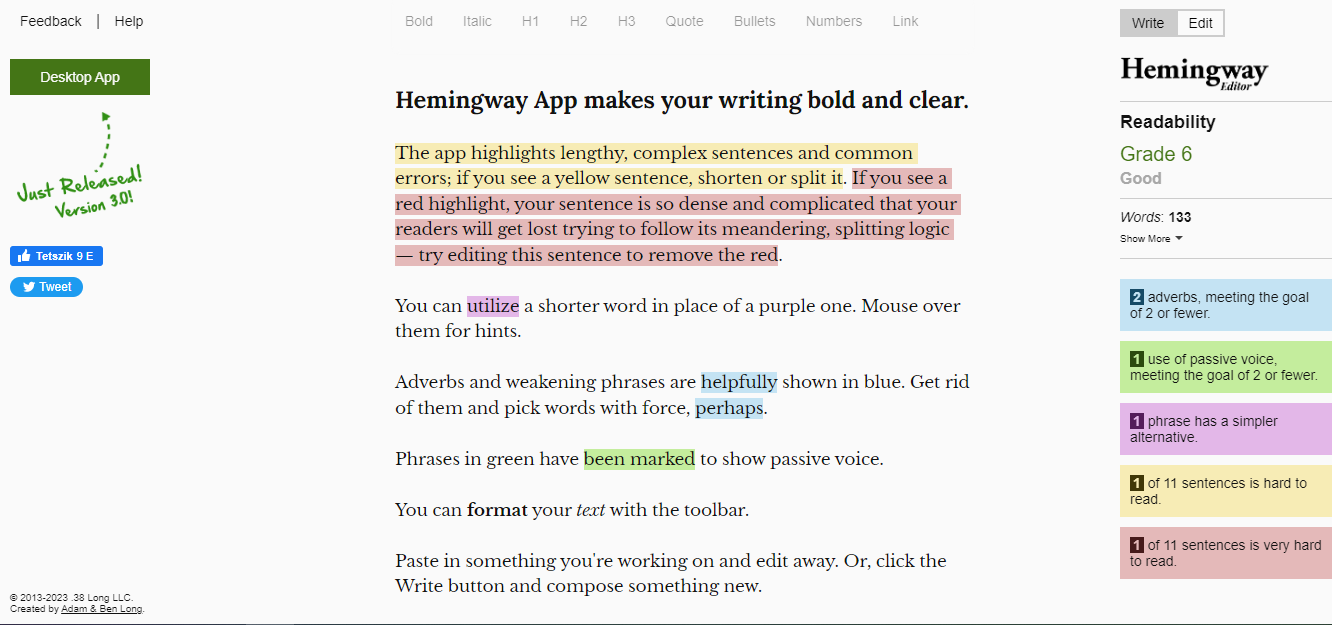
Hemingway is a web-based writing app that helps users improve the clarity and readability of their writing.
The app is named after the famous American author Ernest Hemingway, who was known for his concise and direct writing style.
One of the main features of Hemingway is its editing tool.
Which analyzes text and provides suggestions for improvements in areas such as sentence structure, word choice, and readability.
The app highlights sentences that are difficult to read, identifies adverbs and passive voice, and provides suggestions for simpler alternatives.
In addition to its editing tool, it provides a range of other features to help users improve their writing.
One of these features is a readability score that rates text based on the grade level required to understand it.
This feature is particularly useful for writers who want to make sure that their writing is accessible to a broad audience.
By analyzing text and providing a readability score.
It can help writers ensure that their content is clear and easy to understand.
Another feature of Hemingway is its word count tool, which provides information on the number of words, characters, paragraphs, and sentences in a piece of writing.
This feature is helpful for writers who need to meet specific word count requirements.
Such as those writing articles or essays.
By providing detailed information on the length of a piece of writing.
It can help writers make sure that their content is the right length for its intended purpose.
It is available as a web-based app and as a desktop app for both Mac and Windows.
The web-based version of the app is completely Free to use.
While the desktop app requires a one-time payment of 19.99$.
3 Powerful Content Promotion Tools in 2023

Creating great content is only half the battle.
To ensure that your content gets the attention it deserves, you need to promote it effectively with marketing tools.
Content promotion tools can help you reach a wider audience and drive traffic to your website.
| Content Promotion Tools | Reviews | Price | Users |
| Buzzsumo | ⭐⭐⭐⭐⭐ | 249$/month | 300000+ |
| CoSchedule Headline Analyzer | ⭐⭐⭐⭐ | 39$/month | 50000+ |
| Hootsuite | ⭐⭐⭐⭐ | 249$/month | 200000+ |
1. Buzzsumo
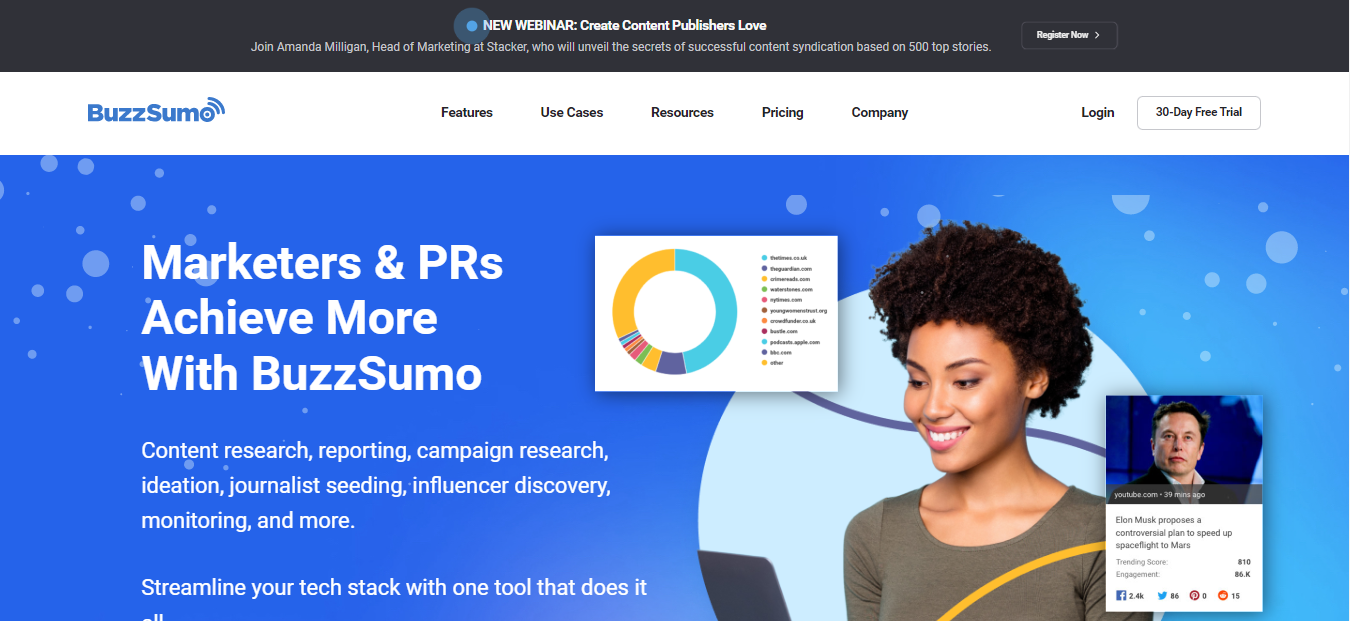
Buzzsumo is a web-based content analysis tool that helps users identify popular and trending content in their industry.
The platform provides insights into the type of content that performs best on various social media platforms, including Facebook, Twitter, LinkedIn, and Pinterest.
One of the primary features of Buzzsumo is its content discovery tool.
Which allows users to search for popular content based on specific topics or keywords.
The tool provides a list of the most shared content on social media related to the search query, along with detailed analytics on engagement and reach.
Another feature of Buzzsumo is its influencer identification tool, which helps users identify key influencers in their industry.
The platform provides data on influencer social media profiles, including their follower count, engagement rate, and average shares per post.
This information can help users identify potential partners for content collaboration or influencer marketing campaigns.
It also offers a range of other features, including competitor analysis tools, content alerts, and content curation tools.
The platform provides users with detailed analytics on their content performance, including data on shares, links, and engagement.
Pricing starts from 119$/month.
2. CoSchedule Headline Analyzer
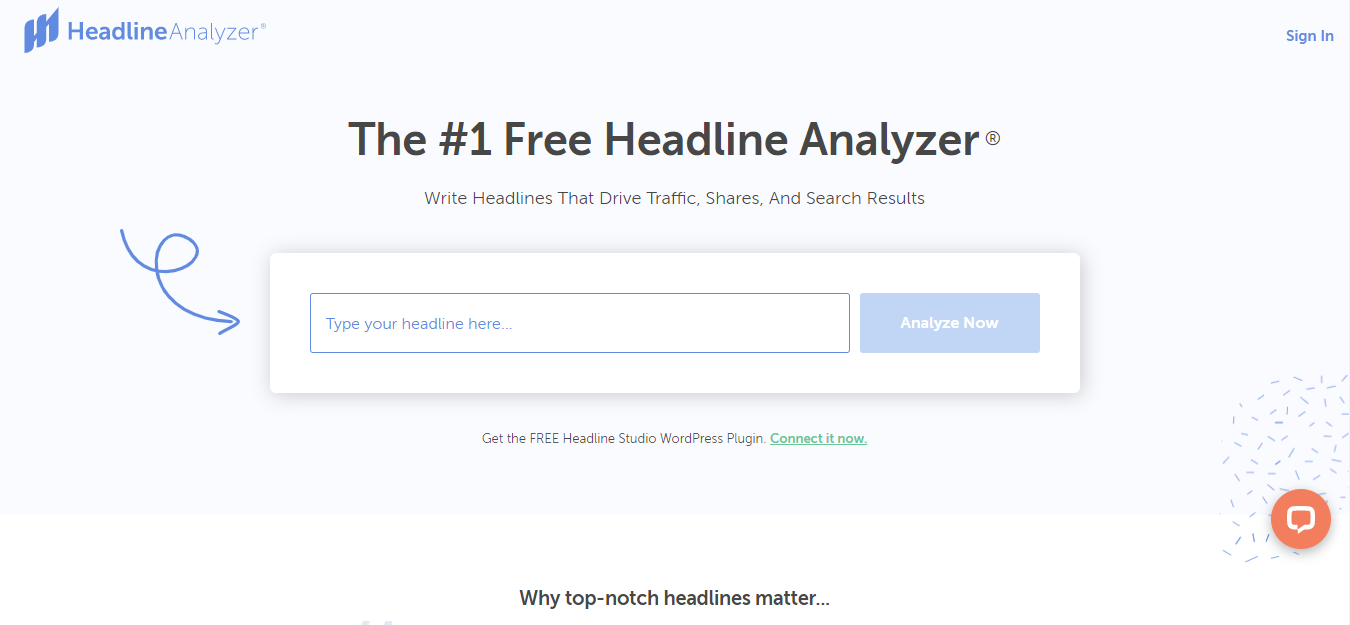
CoSchedule Headline Analyzer is a free online tool that helps users create effective headlines for their blog posts, articles, or social media content.
The tool uses a proprietary algorithm to analyze headlines based on factors such as length, emotional appeal, and keyword usage.
One of the primary benefits of CoSchedule Headline Analyzer is its ability to provide real-time feedback on headline effectiveness.
This allows users to make changes to their headlines on the fly and see how those changes impact their overall score and effectiveness.
To use the tool, users simply enter their headline into the input field, and the tool provides a detailed analysis of its effectiveness.
The analysis includes a headline score, which rates the headline based on its overall effectiveness, and a breakdown of its strengths and weaknesses.
The tool also provides detailed recommendations for improving headlines.
Including suggestions for using stronger emotional language, incorporating powerful words and optimizing keyword usage.
These recommendations can help users with content ideas and create headlines that are more effective at driving traffic and engagement.
In addition to its headline analysis capabilities, it also provides detailed analytics on headline performance.
Users can track metrics such as click-through rates, social shares, and engagement to identify which headlines are most effective at driving traffic and engagement.
The Basic version is Free and the next tier is only 29$/month.
3. Hootsuite

Hootsuite is a popular social media management platform that helps businesses and individuals manage their social media accounts and campaigns.
The platform provides a wide range of features and tools for scheduling posts, monitoring social media activity, tracking site metrics and analyzing your social media campaign performance.
One of the key benefits of Hootsuiteis its ability to manage multiple social media accounts from a single dashboard.
Users can connect all of their social media accounts, including Facebook, Twitter, Instagram, LinkedIn, and more, and manage them all in one place.
This can save users a significant amount of time and effort, allowing them to streamline their social media management and focus on creating great content.
It also provides a powerful scheduling feature, allowing users to schedule posts in advance and set up automated posting schedules.
This can be particularly useful for businesses and individuals who want to maintain a consistent social media presence but don’t have the time to post manually on a regular basis.
In addition to its scheduling capabilities, it provides a range of tools for monitoring social media activity and engaging with followers.
The platform allows users to monitor mentions and comments on social media, and respond to them directly from the Hootsuite dashboard.
This can help businesses and individuals maintain a positive social media presence and build relationships with their followers.
It also provides detailed analytics and reporting features, allowing users to track their social media performance and measure the impact of their social media campaigns.
Users can track metrics such as follower growth, engagement rates, and website traffic, and use this information to refine their social media strategy and improve their overall performance.
Pricing starts from 99$/month.
Top 3 Content Analytics Tools in 2023

To measure the effectiveness of your content marketing efforts.
You need to track key metrics such as website traffic, engagement, and conversions.
Content analytics tools can help you monitor and analyze these metrics, providing valuable insights into your audience’s behavior and preferences.
| Content Analytics Tools | Reviews | Price | Users |
| Google Analytics | ⭐⭐⭐⭐⭐ | Free | 28.1 Million |
| Hotjar | ⭐⭐⭐⭐ | Free+other options | 150000+ |
| HubSpot | ⭐⭐⭐⭐ | 800$/month | 167,000+ |
1. Google Analytics
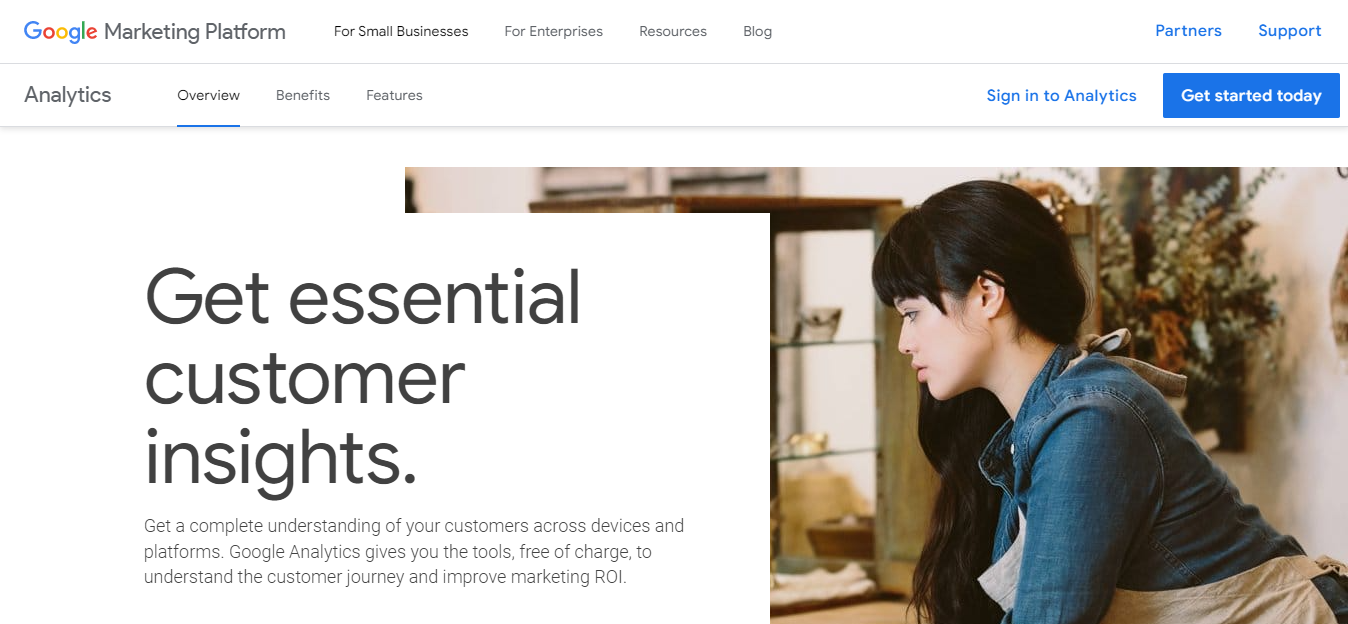
Google Analytics is a free web analytics service provided by Google that helps businesses and website owners track and analyze their website traffic and user behavior.
It allows users to track various metrics related to their website’s performance, including traffic sources, visitor demographics, page views, bounce rates, conversion rates, and more.
One of the key benefits of Google Analytics is its ability to provide real-time data on website traffic and user behavior.
Users can view up-to-the-minute data on their website’s performance.
Including the number of visitors on the site, the pages they are viewing, and the actions they are taking.
It also provides a range of tools for analyzing website traffic and user behavior.
Users can create custom reports to track specific metrics.
Such as the effectiveness of marketing campaigns or the performance of individual pages on the website.
The platform also provides advanced segmentation capabilities.
Allowing users to segment their website traffic based on various criteria, such as traffic source, geography, device type, and more.
In addition to its analytical capabilities, it provides a range of tools for website optimization and marketing.
The platform allows users to set up goals and funnels to track specific user actions on their website.
Such as completing a purchase or filling out a contact form.
It also provides a range of e-commerce tracking features, allowing businesses to track revenue and conversion data from their online store.
Another benefit of Google Analytics is its ability to integrate with other Google services, such as AdWords and Search Console.
This allows users to view a comprehensive view of their online presence and track the effectiveness of their online advertising campaigns.
It is a Free service provided by Google.
2. Hotjar
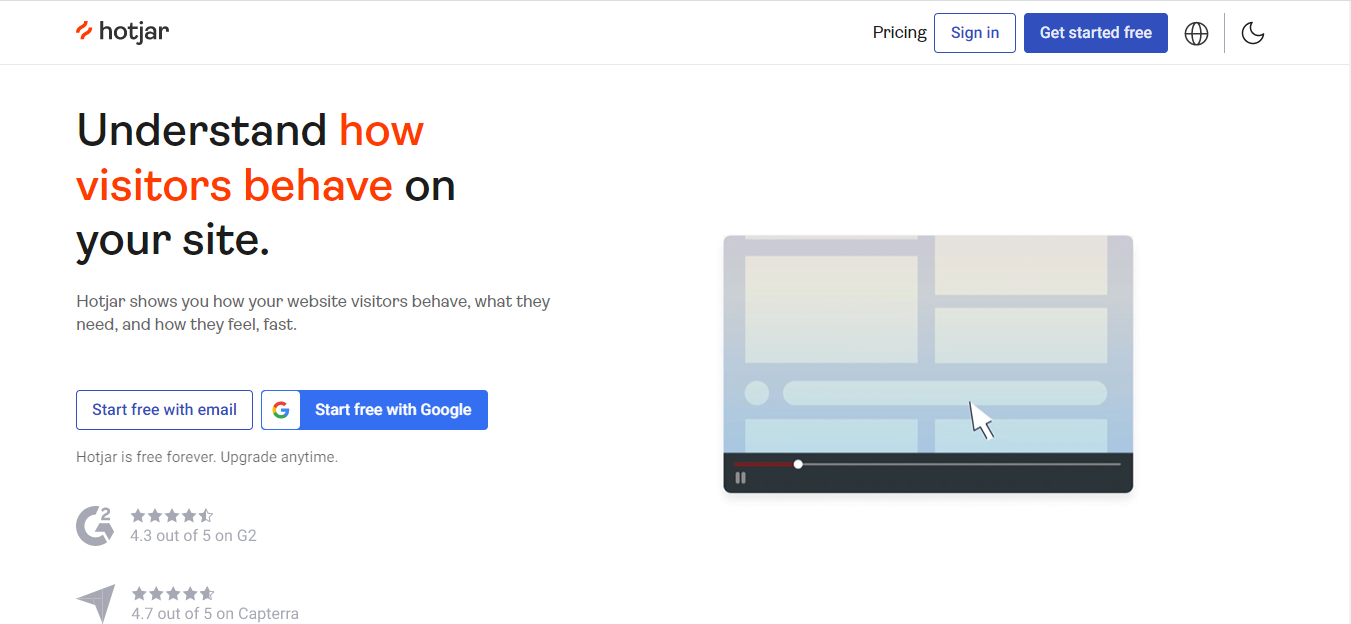
Hotjar is an all-in-one analytics and feedback tool that helps website owners and marketers understand user behavior and optimize their websites for better performance.
It provides a range of features designed to gather insights through heatmaps, recordings, surveys, and feedback polls.
One of the main features of Hotjar is its heatmaps, which visually represent user interaction on a website.
Heatmaps show areas of a webpage where users click, move their mouse, or scroll the most.
This information helps identify which sections of a webpage are engaging and which parts might need improvement.
Heatmaps are available for desktop and mobile views, allowing website owners to optimize their websites for different devices.
It also offers session recordings, which record and playback user sessions on a website.
These recordings allow website owners to watch how users navigate through their site, where they encounter difficulties, or where they abandon their session.
Session recordings provide valuable insights into user behavior.
Allowing website owners to identify usability issues and improve the overall user experience.
Additionally, it offers surveys and feedback polls to gather direct user feedback.
These tools can be used to ask targeted questions to visitors, such as their satisfaction level or reasons for abandoning a purchase.
Collecting user feedback helps uncover valuable insights, allowing website owners to address pain points, improve conversions, and make data-driven decisions.
Hotjar provides an easy-to-use interface and integrates seamlessly with popular platforms such as WordPress, Shopify, and Google Analytics.
The platform also prioritizes user privacy and offers features like GDPR compliance and the ability to mask sensitive data in session recordings.
The Basic packages are Free, but there are many other packages you can choose from.
3. HubSpot
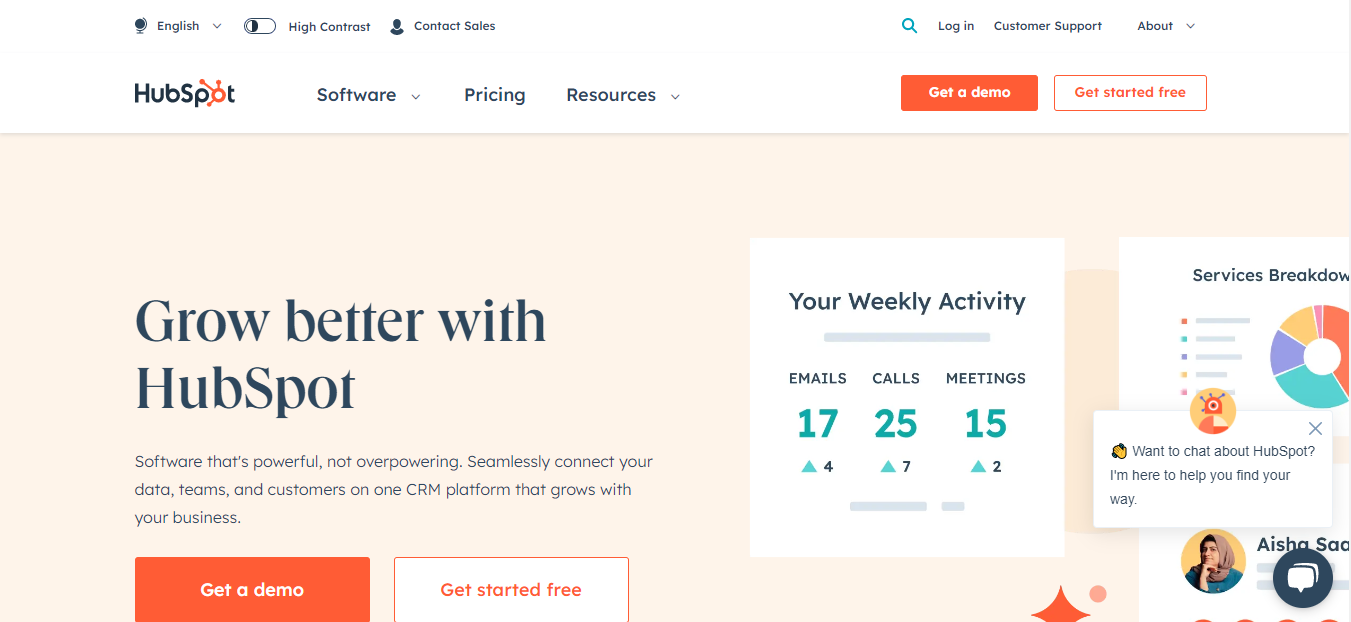
HubSpot is an all-in-one inbound marketing, sales, and customer relationship management (CRM) software platform that helps businesses attract, engage, and delight customers.
It offers a range of tools and features designed to help businesses grow by bringing all their customer interactions into one place.
One of the key features of HubSpot is its marketing automation tools.
Which include email marketing, landing pages, forms, and lead tracking.
These tools enable businesses to create and execute effective inbound marketing campaigns.
Which in turn generate leads, nurture them, and convert them into customers.
Another important feature of HubSpot is its CRM, which allows businesses to manage all their customer data in one place.
The CRM provides a complete view of each customer’s interactions with the business.
Including their website activity, email engagement, social media interactions, and sales history.
This information enables businesses to understand their customers better and provide personalized experiences that meet their needs.
It also offers a sales hub, which provides tools for sales teams to manage their pipeline, track deals, and automate their workflows.
This enables sales teams to focus on selling and building relationships with their customers, rather than on administrative tasks.
Furthermore, it provides a customer service hub, which enables businesses to manage their customer support tickets, chat with customers in real-time, and create knowledge base articles.
This feature allows businesses to provide exceptional customer support experiences, which can lead to higher customer satisfaction and retention rates.
HubSpot integrates with a range of other tools and platforms, including social media, analytics, and content management systems.
This integration allows businesses to streamline their marketing, sales, and customer service processes, making them more efficient and effective.
Pricing starts from 800$/month
The 4 Best Content Management Tools in 2023

As your content library grows, it becomes increasingly important to have a system in place to manage and organize your content.
Content management tools can help you streamline your workflow, collaborate with team members, make content marketing workflows and ensure that your content marketing tool is consistent and on-brand.
| Content Management Tools | Reviews | Price | Users |
| WordPress | ⭐⭐⭐⭐⭐ | Free | 810 million |
| Drupal | ⭐⭐⭐⭐ | Free | 1.7 million+ |
| Joomla | ⭐⭐⭐⭐ | 99$/year | 2.5 million |
| GatherContent | ⭐⭐⭐⭐ | 99$/month | 2000+ |
1. WordPress
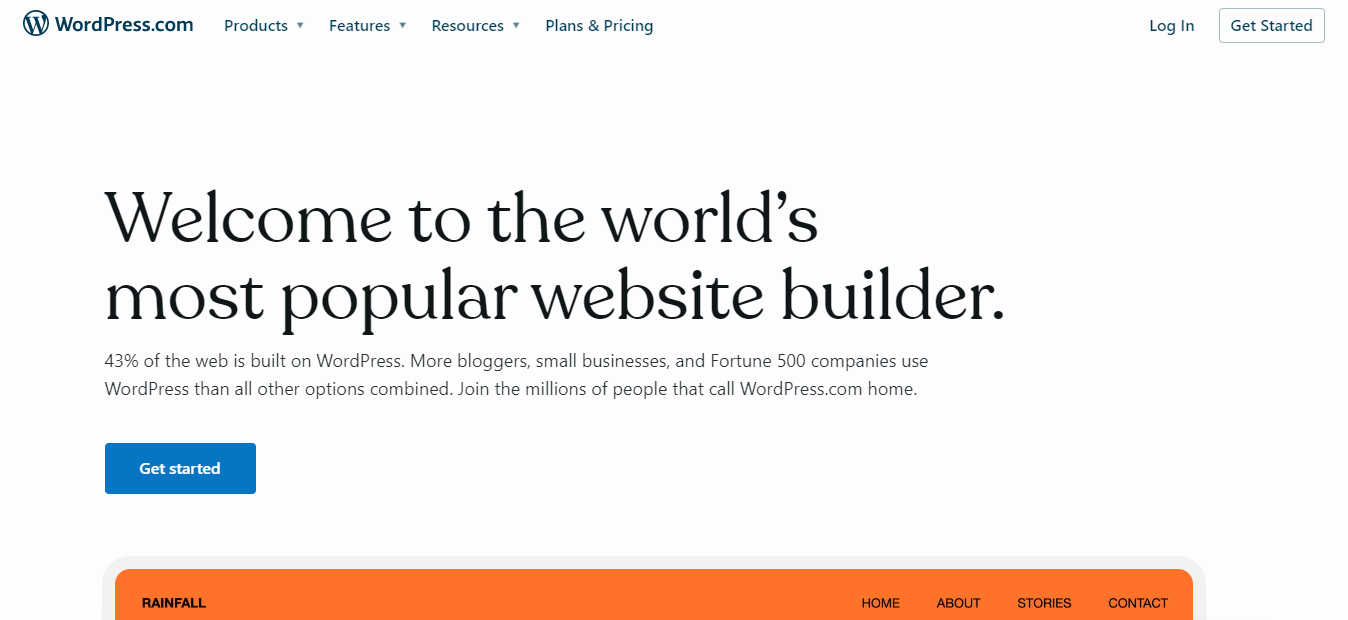
WordPress is a free and open-source content management system (CMS) that powers over 40% of websites on the internet.
It is a flexible platform that allows users to easily create and manage their own websites.
One of the key features of WordPress is its user-friendly interface, which makes it easy for beginners to get started.
The platform offers a range of templates, called themes, that can be customized to suit individual needs.
Users can also install plugins, which are apps that extend the functionality of the website.
Add features like contact forms, social media sharing buttons, and search engine optimization tools.
WordPress is highly customizable, with users able to edit the code and design of their website to meet their specific needs.
This makes it a popular choice for businesses of all sizes, from small startups to large corporations.
WordPress is also search engine friendly, with built-in SEO features that make it easy for websites to rank well in search results.
The platform is also designed to be mobile responsive.
This means that websites created on it can be accessed on mobile devices with ease.
WordPress offers a range of options for website hosting, from self-hosting to managed hosting.
Self-hosting requires users to manage their own website.
While managed hosting offers a range of services including automatic updates, backups, and security.
WordPress is a Free CMS and is often considered to be the best option for beginners or even advanced users.
2. Drupal
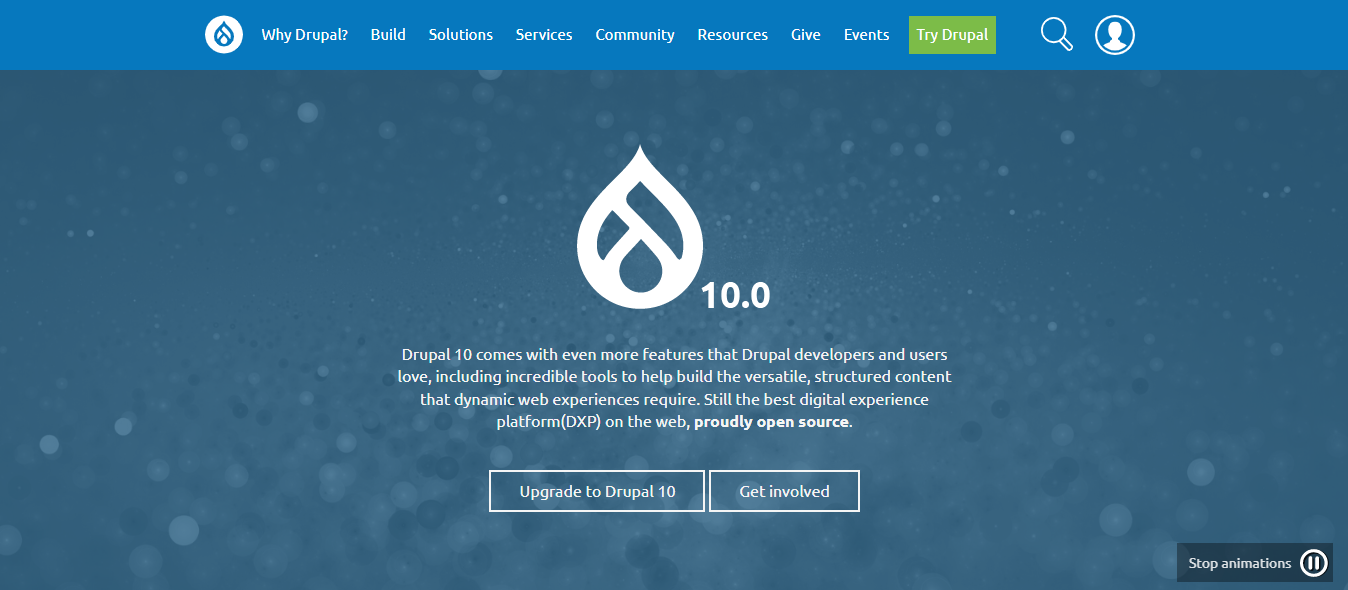
Drupal is a PHP-based open-source content management system (CMS) used for developing websites and applications.
It is popular because of its scalability and flexibility, making it ideal for large and complex websites and applications.
Drupal’s robust taxonomy and advanced user management features allow for complex content categorization schemes and granular user permissions and roles.
It has a variety of content creation and management tools, including a WYSIWYG editor, customizable content types, and revision control.
The platform has an active developer community that contributes to its development and offers a wide range of plugins and modules to extend its functionality.
It is also known for its strong security focus, with regular updates and patches to address vulnerabilities.
Although Drupal may have a steeper learning curve than other CMS options, it can be a suitable option for organizations that require a high level of customization and scalability for their website or application.
It is a Free CMS, so it is a very reasonable budget option.
3. Joomla
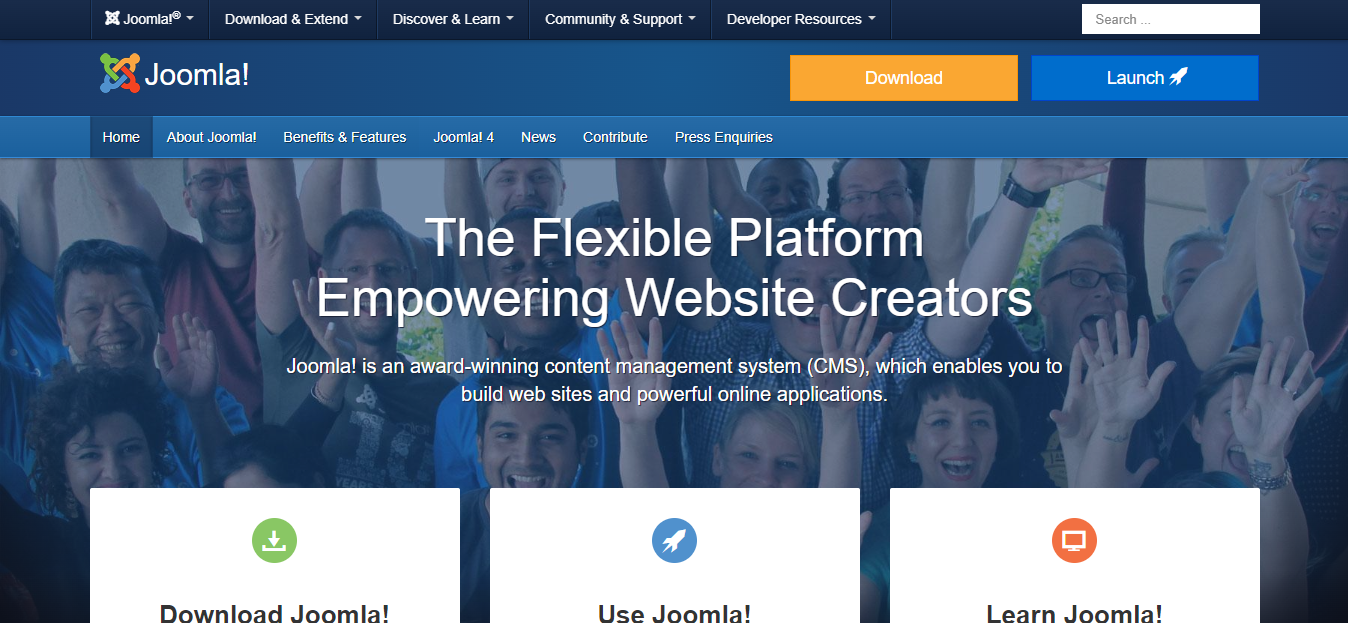
Joomla is a popular open-source content management system (CMS) that enables users to create websites and applications.
It is built on top of a MySQL or PostgreSQL database and, like Drupal, is written in PHP.
Joomla is specifically designed to offer a range of advanced features and capabilities.
This makes it well-suited for building complex websites and applications.
One of the main benefits of Joomlais its user-friendly interface.
This makes it easy for users with limited technical skills to create and manage content on their website.
Additionally, it provides a variety of templates and extensions that can be used to customize the appearance of your site.
It also includes a range of powerful content creation and management tools.
Such as a WYSIWYG editor, customizable content types, and revision control.
Furthermore, it has a vast and active developer community that contributes to the platform’s development and provides numerous plugins and modules to extend its functionality.
Like Drupal, Joomla prioritizes security and is designed to be secure out of the box.
Joomla has a dedicated security team that frequently releases updates and patches to address any vulnerabilities that may arise.
Overall, it is a powerful and user-friendly CMS that provides various advanced features and capabilities.
While it may not be as flexible as Drupal, it can be a great choice for organizations that need a CMS that is easy to use and offers a high level of customization and scalability in their website or application.
Pricing starts from as low as 99$/year
4. GatherContent

GatherContent is a web-based content management tool that allows you to streamline your content creation process by centralizing all your content in one place.
It is designed to help teams streamline their content creation and collaboration process.
It offers a range of features and capabilities that can help teams work more efficiently and effectively.
Including content planning and organization, editing, content approval and publishing.
One of the key benefits of GatherContent is its content planning and organization capabilities.
It offers features such as content marketing templates, workflow, a competent project management tool, and collaboration tools, as well as a visual content calendar that helps you track your content production timeline.
This can help ensure that all team members are on the same page and that content is produced and delivered on time.
It also offers a range of content creation and editing tools.
Including a WYSIWYG editor and the ability to add custom fields to your content types.
This can help ensure that your content is consistent and meets your organization’s standards.
Finally, It integrates with a range of third-party tools, including CMS platforms, project management tools, and marketing automation tools.
This can help teams manage their content more effectively across their entire workflow.
Pricing startsfrom 99$/month
Conclusion

Effective content marketing requires a strategic approach and the right tools to execute that strategy.
The tools mentioned above can help you at every stage of the content creation process, from research to content promotion and analytics.
By incorporating the best content marketing tools into your content marketing strategy, you can save time, improve the quality of your content, and ultimately achieve better results.
Remember, content marketing is a long-term strategy, and success requires patience, persistence, and a commitment to creating high-quality, valuable content that resonates with your target audience.
If you liked this article, consider reading about Content Optimization Tools for WordPress here.
FAQ
Effective strategies for creating engaging social media posts in a content marketing campaign include using visual content, keeping blog post messaging clear and concise, using hashtags, posting consistently, and encouraging engagement with blog posts through questions, polls, and contests.
Google Docs is a cloud-based platform that offers collaborative tools, editing and revision history, and content planning capabilities to support content marketing efforts.
It can also be used to create promotional materials and streamline the content creation process for teams.
